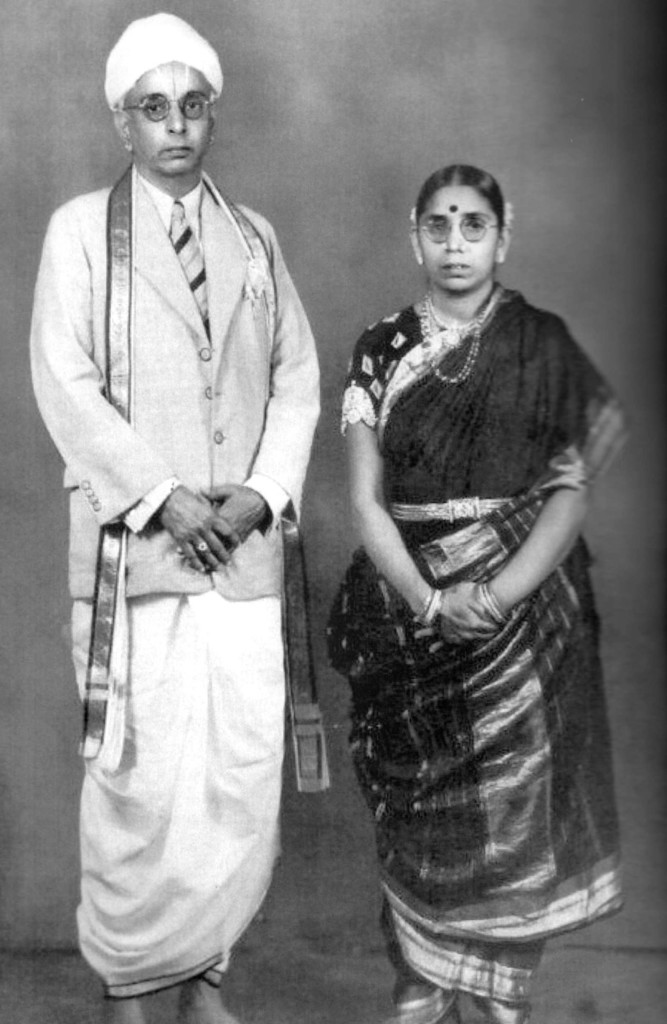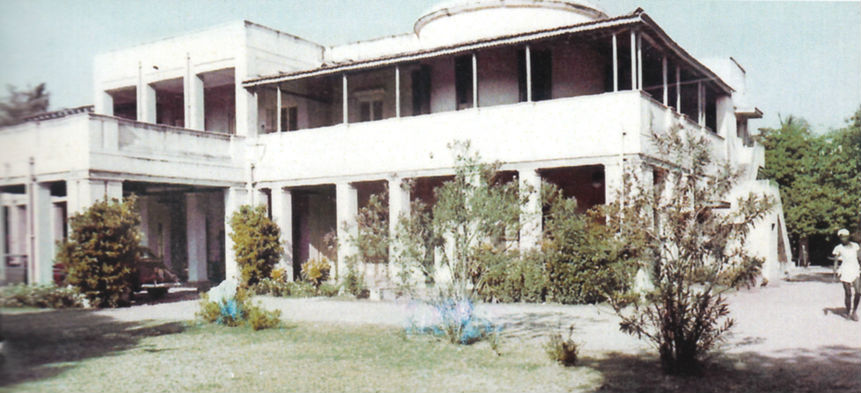Registered with the Registrar of Newspapers for India under R.N.I 53640/91
Vol. XXVII No. 4, June 1-15, 2017
The Timber Kings

Seshadri Iyengar and Kamalammal
The story of the Madabushi Seshadri Iyengar family is a slim, tastefully brought out volume written and edited by a grand-daughter of the family, Radha Padmanabhan. Seshadri Iyengar was one of four brothers, whose family was from Tekkalore, a small village near Tiruttani. An orthodox, Vaishnavite family, they were engaged in agriculture and were also given the right to make the laddu-s for the Tirupathi Venkateswara temple.
This gave the family both a sizeable income as well as the right to have darshan of Lord Venkateswara from within the sanctum. The practice of leasing out the manufacture of laddu-s to private families was, however, abolished by the Andhra government in 1987.
Seshadri Iyengar’s eldest brother, Doraisamy Iyengar, moved to Madras in the 1800s and began a timber business. His brothers joined him in the business in the coming years and the business flourished under the name of Doraisamy Iyengar and Brothers. They rented a house in China Bazaar and lived with their families downstairs while the upper floors were used as their business office. The building no longer exists, but the business is described in a book written by Somerset Playne, Southern India, Its History, People, Commerce, and Industrial Resources. The book records that the firm “irtually commanded the Madras timber market”. Playne, who obviously did not know the brothers personally, also referred to them as “University men possessing… high educational attainments.” An amusing assumption, the author notes wryly. The firm also became agents for Shaw Wallace & Co. who went on to found the Bombay Burma Trading Corporation and imported teak from Burma and Siam for use as ‘sleepers’ on railway tracks in India. Doraisamy Iyengar borrowed money from his father to get this agency. It proved to be a very fruitful investment. The brothers then began importing logs from Bangkok, Mandalay, Java, Singapore and the Andaman Islands, “square and round logs, battens, scantlings, planks, posts, boards, sleepers, flitches.” The list reads like a lyrical roster. The firm gained a reputation for honesty and for holding a huge stock and, therefore, being able to supply timber of any quality and quantity promptly.
In the 1920s, with a considerable expansion of business, the brothers moved to a house in Randall’s Road, Egmore. The China Bazaar property was retained for business. The new house, Srinivas, was a traditional one, with a huge courtyard and surrounding rooms. Radha recalls a beautiful glass painting of the Dashavatharam adorning the front door and stained glass on many windows. The house was set in 2.2 acre plot that housed horse stables, carriage sheds, garages for three cars
(a Buick, a Plymouth and a Hupmobile). The children went to school in the horse carriages, the men travelled by car. The brothers played billiards at Suguna Vilas Sabha after office. Drives to the Marina in the Hupmobile (the roof opened out) were frequent outings for the children. The house even had a fine cricket pitch (Seshadri Iyengar was a left-handed bowler). The family watched cricket matches at Chepauk (food and tiffin were, however, supplied from home as orthodoxy would not allow even the children to eat food from outside). At any given time 30 and more family members lived in Srinivas.

Soundarya
Ruling over this huge family was Seshadri Iyengar’s wife Kamala who seems to have been a formidable lady. Married at nine to Seshadri Iyengar (who was then 18), Kamala obviously saw all the ups and downs of her husband’s business, took the running of a complicated household in her stride and, despite her reputation as a strong-willed woman whose word was law in the family, was also known to be extremely generous to all relatives. Fond of silks and jewellery, Kamala always wore what seems now like a major fortune in gems and gold. She wore huge diamond earrings and nose studs, a diamond addigai, several gold chains, three strands of Navaratna stones, several gold bangles and a gold belt with her initials studded in diamonds. This was what she wore on a daily basis. (Her fondness for jewellery was such that she often had two jewellers working right through the day at home to make jewellery for herself and for the family). Adventurous by nature, Kamala was not averse to taking a plane ride to drop her grand-daughter off in Calcutta. She travelled by a Dakota that had to stop at Visakhapatnam on the way back to Madras to refuel. While all other passengers were escorted to the lounge for refreshment, Kamala chose to sit on a chair in the shade of the wing of the plane and eat the curd rice she had brought with her!
Many years later when the family business split in 1938, Seshadri Iyengar moved house again, to Soundarya in Eldam’s Road, Alwarpet. The house on the 24-ground property was somewhat dilapidated and Seshadri Iyengar paid Rs. 55,000 for it. Gannon Dunkerley, the building firm, renovated it into a beautiful home which has a wealth of gleaming rosewood furniture. The land had originally belonged to the well known Madras nursery, Soundarya Nursery, and the name was retained for the house. The land around the house had an incredible variety of fruit- and flower-bearing trees and bushes. The property stretched from Eldam’s Road to Murray’s Gate Road and the house faced Mowbray’s Road. Seshadri Iyengar and Kamala lived here until their death and the house became a hub for the entire extended family. After their deaths, the house was torn down and apartments and bungalows have been built on the property for various family members.
This account of Seshadri Iyengar and his family is absorbing to read for the simple reason that it tells of the lifestyle of a certain class of affluent people in Madras in the earlier half of the 20th Century. Seen from this distance, their ways, their quirks, even their orthodoxy, seem quaint and lovable.
A similar offering but one that goes flat for the reader outside the family reading circle is the biography of P.V. Rama Iyengar of Arni. Rama Iyengar was an eminent lawyer who practised in Arni, near Vellore. By a strange coincidence, I discovered he was also a son-in-law of the Madabushi Seshadri Iyengar family. This biography is a collection of remembrances by the children and grandchildren of Rama Iyengar and his charming wife Sugantha. While we get some idea of how a traditional, middle class, joint family lived in the suburbs, it is mostly run-of-the- mill information. Perhaps this is because it is a loose collection of remembrances by many relatives and often the memories are repetitive or overlap. This book is strictly for the family.

